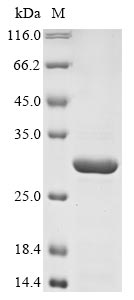Recombinant Escherichia coli RNA polymerase sigma factor for flagellar operon (fliA) is expressed in E. coli (strain K12) and contains the complete protein sequence from amino acids 1 to 239. This product comes without any tags, which appears to preserve the native protein structure and function. Purity exceeds 85% as determined by SDS-PAGE analysis, making it appropriate for various experimental applications that demand high-quality reagents.
The sigma factor fliA in Escherichia coli seems crucial for initiating transcription of the flagellar operon. It likely plays an important role in regulating flagellum assembly—a key component for bacterial movement. This protein may be essential for studying how bacteria move and how gene expression is controlled in prokaryotes, potentially offering insights into the intricate mechanisms behind bacterial adaptation and survival.
Potential Applications
Note: The applications listed below are based on what we know about this protein's biological functions, published research, and experience from experts in the field. However, we haven't fully tested all of these applications ourselves yet. We'd recommend running some preliminary tests first to make sure they work for your specific research goals.
Escherichia coli FliA sigma factor is a bacterial transcription factor that requires precise folding, proper domain organization for RNA polymerase core enzyme binding, and specific promoter recognition capabilities for its functional activity in flagellar gene expression. The E. coli expression system is homologous to this protein, which significantly increases the probability of correct folding and functionality. The full-length protein (1-239aa) contains all functional domains, and the absence of affinity tags eliminates potential steric interference. While the homologous expression strongly supports proper folding, the probability of correct folding with functional sigma factor activity requires experimental validation of RNA polymerase binding and promoter recognition capability.
1. In Vitro Transcription Assays for Flagellar Gene Expression Studies
This application is highly suitable if RNA polymerase binding is validated. The FliA function requires proper folding to form functional holoenzyme complexes with core RNA polymerase. The homologous E. coli expression system strongly supports correct folding. If verified active through binding and transcription assays, the protein is excellent for promoter specificity and transcription initiation studies.
2. Protein-DNA Interaction Studies
This application carries significant limitations. Sigma factors like FliA typically bind promoter DNA specifically only when complexed with core RNA polymerase. The sigma factor alone may not exhibit specific DNA binding. Studies should be conducted with the reconstituted holoenzyme rather than FliA alone to obtain biologically relevant results.
3. Biochemical Characterization and Structural Studies
These studies are highly suitable. The tag-free, full-length protein is ideal for biophysical characterization, including circular dichroism spectroscopy, analytical ultracentrifugation, and structural studies. The homologous expression ensures proper folding for meaningful structural analysis.
4. Antibody Development and Validation
This application is highly suitable. The full-length, tag-free protein provides authentic epitopes for generating FliA-specific antibodies. The high purity ensures minimal cross-reactivity, and the homologous expression supports proper folding for conformational epitope recognition.
5. Comparative Sigma Factor Studies
This application is suitable if the functionality is validated. Comparative studies require native conformation and RNA polymerase binding activity. If correctly folded and active (verified), the protein enables valid evolutionary and functional comparisons with other sigma factors.
Final Recommendation & Action Plan
The E. coli-expressed, tag-free FliA sigma factor has a high probability of correct folding and functionality due to the homologous expression system. Begin with functional validation using RNA polymerase core enzyme binding assays and in vitro transcription assays to confirm promoter specificity and transcriptional activity. Applications 3 and 4 (biochemical characterization and antibody development) can proceed immediately. Applications 1 and 5 require functional validation before use. Application 2 (DNA binding) should only be conducted with properly reconstituted RNA polymerase holoenzyme complexes to ensure biologically relevant results. The tag-free nature of this protein makes it particularly valuable for structural studies and interaction analyses.






